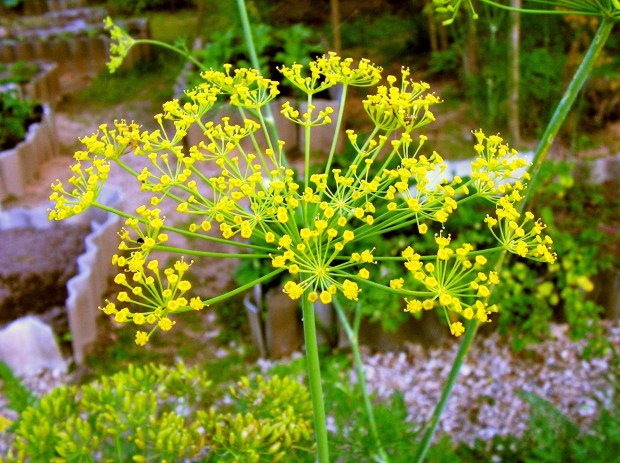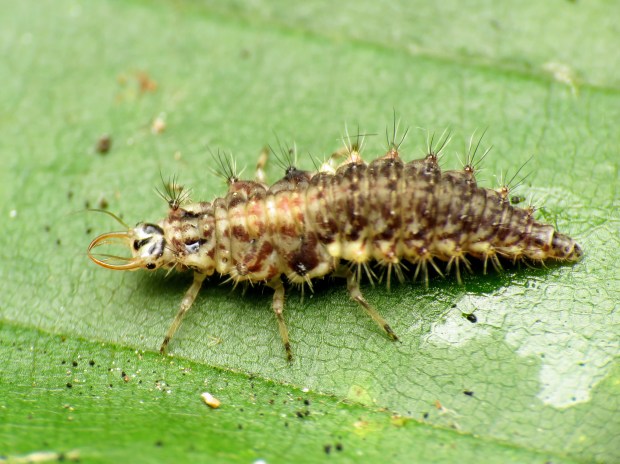Mix up your plantings to include a wide variety of types, heights and blooming seasons to provide for different insect species and life stages. (Photo by Nanette Londeree)

Syrphid fly larvae are voracious predators of aphids. (Photo by Nanette Londeree)

Dill (Anethum graveolens) is one of many flowering plants in the carrot family that are highly attractive to beneficial insects. (Courtesy of Wikimedia Commons)

The larvae of green lacewings are aggressive predators, while the adults feed only on pollen and nectar. (Courtesy of Wikimedia Commons)
Show Caption
1 of 4
Mix up your plantings to include a wide variety of types, heights and blooming seasons to provide for different insect species and life stages. (Photo by Nanette Londeree)
Expand
Insects — they’re everywhere! With nearly 1 million named species, they make up about 90% of all species of animals on the planet and more than half of all living things on Earth. Yet it’s estimated that only about 1% to 3% are truly harmful. Most insects go about their daily business pollinating plants, helping decompose dead material or ending up as meals for birds, fish and other creatures — a part of nature’s food chain. One big service that a number of insects provide, hidden from most of us, is keeping pest populations down — the good bugs battling the bad ones.
Natural enemies, also known as beneficials, biological pest control and good bugs, are the predators that attack, kill and feed on their prey, the parasites that feed on or inside other insects, killing their hosts and the pathogens (disease-producing organisms) that can infect and kill the host. While the majority of beneficials are insects, there are also spiders and mites (arachnids), nematodes and a wide range of microbes.
Getting to know the good guys is the first step in effective biological pest control. Some common beneficials you may find in the garden include:
• Ladybugs. The adult reddish-orange beetle and its larval stage, which looks like a small alligator, are both predators with enormous appetites.
• Green lacewing adults. The ethereal-looking insect with a slender pale green body and immense golden eyes isn’t a predator at all, feeding on pollen and nectar. But their immature form, also resembling a tiny alligator, is an aggressive predator.
• Soldier beetles. They are predators of aphids and other soft-bodied insects. Adults are straight-sided beetles about a half-inch long with a red, orange or yellow head and abdomen.
• Syrphid flies. Also known as hoverflies, they resemble bees. The brightly colored adults are black or brown with yellow-banded abdomens and body markings. Their caterpillar-looking larvae are the predators. Adults feast on pollen and nectar and are considered an important pollinator.
• Spiders. They are major predators in the garden; some capture prey in silken webs, while others stalk insects across the ground or vegetation or lie in wait and pounce on prey.
Encouraging beneficials in your garden is about the greenest method of pest control you can use. Like any living creature, these good guys need food, water and shelter, all generally available in the garden. Here are some ways to attract and keep them around:
• Use diverse types of plants — natives, annuals, perennials and herbs — to encourage a range of beneficials.
• Use sequentially flowering species to provide nectar, pollen and shelter throughout the growing season.
• Include plants with many small flowers; they are preferred by many beneficial insects over those with large single flowers.
• Create plantings of varied heights in sun and shade to provide food and habitat for different insect species and life stages.
• Maintain groundcovers and coarse mulches for nonflying predators to hide from their enemies.
• Provide water. A shallow dish of water filled with pebbles or gravel and placed in a sheltered area will give small beneficials a safe place to slurp.
• Tolerate low populations of plant-feeding insects and mites so that food is available for the predators.
• Go light on fertilizer; lush new plant growth encourages sucking pests like aphids to reproduce more rapidly than natural enemies may be able to control.
• Avoid the use of pesticides; they don’t discriminate between good and bad bugs.
These families of plants are attractive to multiple life stages of numerous beneficial insects:
• Carrot (Apiaceae): cilantro, dill, fennel and Queen Anne’s lace
• Aster (Asteraceae): coneflower, coreopsis, goldenrod, sunflower and yarrow
• Bean (Fabaceae): alfalfa, fava bean and sweet clover
• Mustard (Brassicaceae): mustards and sweet alyssum
• Verbena (Verbenaceae): lantana and verbena
Providing the basics of food, water and shelter to natural enemies in your garden is pretty easy and has a terrific payback by helping to keep pest populations at a tolerable level.
Sponsored by UC Cooperative Extension, the University of California Marin Master Gardeners provides science- and research-based information for Marin home gardeners. Email questions to helpdesk@marinmg.org. Attach photos for inquiries about plant pests or diseases. Please call 415-473-4910 to see when a master gardener will be at the office or drop off samples 24/7 in the sample box outside the office. To attend a gardening workshop or subscribe to Leaflet, a free quarterly e-newsletter, go to marinmg.ucanr.edu.


Comments are closed.